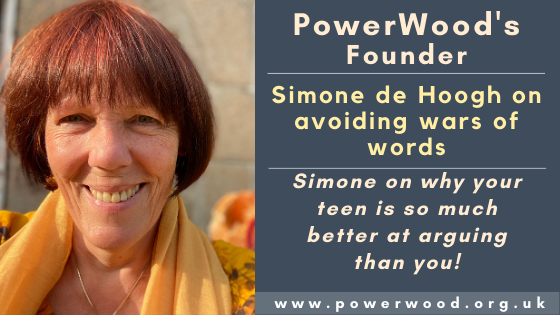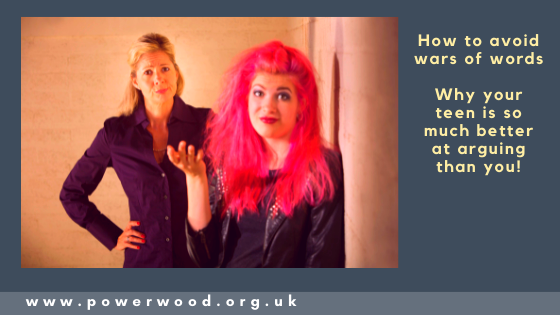
One of the most unsettling issues within families can be argumentative talk. If we have children that are really good at arguing, we might have to ask ourselves where they have learned it. In the case of our children, they usually learned it from the best – their parents.
Example
When our daughter was two-and-a-half years old she wrote her name NOAH with crayons in big different-coloured letters on our beautiful wooden cupboard. When I saw this expression of her creativity and pointed it out to her, she must have directly intuited that I didn’t think it had been a good idea. She immediately expressed her innocence, arguing that it wasn’t her crayons and that her brother, who was one at the time and could neither write nor speak, was to blame.
I found it really sweet at the time that our daughter was so innocent it hadn’t occurred to her that we might see through her story. She evidently hadn’t thought it through (that didn’t last much longer!).
Although we had to laugh very much when she pointed the finger at her brother, her quickness in apportioning blame reminded me of the pointless arguments I and my husband had over household chores, and we wondered to what extent our daughter’s reaction was informed by our modelling this type of behaviour.
If you recognise this, the easiest way to change the way our children communicate is to change our own way of communication with our partner.
The American psychologist John Gottman, who specialised in divorce prediction and marital stability, defined four enemies of a good relationship: criticism, stonewalling, defensiveness and contempt. In general these behaviours are stress responses. Argumentative talk is one of the behaviours falling under ‘criticism’, and is often combined with another unhelpful behaviour ‘defensiveness’.
Seeking Safety
Children need to feel safe.
Children with intellectual and/or psychomotor overexcitability (OE), when triggered in the stress response, can apply argumentative talk to create a false sense of safety. At this point the child is in the Cycle of Emotional and Sensory Overload and in this state can be using every comment or demand as a starting point for argumentative talk, or inappropriate back talking. All they want to achieve subconsciously is that we lose our calm so they feel in control and can have this false sense of safety.
Often those children have been modelled this fight stress-response behaviour by their parents or other close family members, who in turn have been taught this behaviour by their parents, etc.
If that is the case, ask yourself if the argumentative behaviour between the two of you as parents is constructively helping towards a positive solution, or is only adding stress to the situation. If the latter is the case, you might want to stop arguing with your partner and model to your children that there is another way of communicating that is constructive and respectful. It is possible to change the dynamic of the relationship with your child’s other parent by implementing changes to your own behaviour – if you change step, your partner has to as well.

Enemies of healthy relationships / marriages
In a 14-year longitudinal study by Levenson & Gottman, it was found that couples who used the Four Horsemen of the Apocalypse (criticism, contempt, stonewalling and defensiveness) divorced an average of 5.6 years after the wedding, while emotionally disengaged (absence of positive affect during conflict: no interest, affection, humour, or empathy) couples divorced an average of 16.2 years after the wedding. Their research was so accurate that not only did it allow the researchers to predict if a couple would divorce, but when.
In research, Gottman confirmed the influence of The Four Horsemen of the Apocalypse on any relationship.
Argumentative talk is very common between many of us, however if it happens in a stress response it doesn’t leave space for positive connection, which is the fertile ground needed in any family for children to feel and grow up safely.
We are the model
Children do not do what we tell them, they will do what we do. If we smoke, they are likely to start smoking, if we tell them to not argue while we argue with our spouse, they will argue. Even worse, they will be really good at it, as they have learnt the skill to argue from experienced adults – us.
Willpower battle
When our child manages to trigger us into entering into argumentative talk, be aware that this is a willpower battle, which for the child has only one subconscious aim and that is to create a false sense of safety. When we enter into a willpower battle with a child, we will always lose. This is because our child has no other agenda than to trigger us into the Cycle of Emotional and Sensory Overload, while our agenda is overflowing with other goals we want to achieve, e.g. getting on time at school, getting them to be quiet, be polite, to say sorry, doing the laundry, getting to the shop before it closes etc.
How to react to argumentative talk
If we notice that we are responding to, or starting to argue with, our child or our partner (even if it is days later) we can apply the awareness mantra “I’m really proud and grateful to be aware that my behaviour is not helpful and will do the 4-7-8”. And remove ourselves from the situation.
Our argumentative child
Please keep in mind that our children react to how we feel and not what we say. So if we don’t feel calm, it is better not to react at all and just ignore whatever they are saying.
Unfortunately, as soon as we are emotionally invested in how our child is feeling or behaving, whatever we are saying will not work. If how our child is feeling or behaving defines how we are feeling and behaving, e.g. that we find it hard to relax when our child still has to do homework, their behaviour gives them the edge. This is because through their own behaviour and through our reaction they will be able to access a false sense of safety in the Cycle of Emotional and Sensual Overload.
When our child starts to argue, remind yourself that he or she is in the stress response, so not feeling really great.
Negotiation
Although negotiating seems a very rational option, in reality it often means it is not really clear to our child what we want. It may appear that we are afraid to stand our ground and are trying to smooth the way. If we are open to negotiation, the message our child receives is that they might be able to persuade us – and they will do their utmost to get us where they want us to be. Negotiation, therefore, opens the door to argumentative talk.
The value of emotions: you can’t argue about them
Our 13 year old says: “You didn’t buy any crisps. There’s never anything to eat in this house”.
He or she is grumpy because they have a lot of homework to do on which they don’t want to get started, on top of which they are experiencing all kinds of uncomfortable feelings due to hormonal changes.
We can apply our intellectual ability and ask ourselves ”Did my child use criticism, contempt, stonewalling or defensiveness?”: If we recognise one of those we know he or she is in a stress response and his words, in this case all criticisms, are just utterings stemming from how they feel. It is not helpful for them, nor for us, to take them seriously. We know our child’s aim is to upset us so that he or she can access their false sense of safety.
Do’s
- If possible, we do the 4-7-8 to up our baseline before we say anything, so we don’t bring our own emotions into the equation.
- We take the words uttered as an expression of his or her emotions. Anything he or she says isn’t saying anything about us, it only reflects how he or she feels, we don’t take it personally.
- We react to the feelings underneath the words. We move to the emotions involved (because we can’t argue about feelings, only about facts), and that can be ours or our child’s, if we’re sure that reacting to their emotions won’t trigger him or her.
- We are succinct, especially to children with more rigid or thick boundaries who don’t do well on too much information (for further information read the introduction the the Introduction Boundaries in the Mind).
- If possible, we touch our child to stimulate bonding hormones such as oxytocin, because that is the easiest way to calm a human.
So, in the example given above, we could react by simply ignoring their words and saying: “Oh sweetheart, You must feel awful, otherwise you would never say that,” and hug tightly, or whatever type of touch is appreciated by your child.
You can say: “I’m so glad that you are in my life.”
Or, we could make a joke of it (if we’re sure that it won’t trigger our child): “Ah, but I did remember to buy spinach. Can I tempt you with some spinach? I’ll just pick off the caterpillars…” and laugh – laughing together is a great tension release.
Our own reality
Everybody lives in their own reality, there is no right or wrong. Together as a family unit we have to find a practical way in which we respect each other’s responsibilities, duties and realities by communicating in a constructive and respectful way and by being accepting of different views. If we, the parents, model that to our children, they will learn those skills through assimilation.
© Simone de Hoogh 2020
Help us to continue support to all neurodiverse families and individuals
During these challenging times PowerWood facilitates access – also to non-members – to all information, tests, strategies and tools.
PowerWood offers to (self)-isolating families understanding, simple tools and strategies that enable us and our children to support ourselves and our children through emotional overwhelm. If you enjoy reading the articles please support PowerWood by becoming a PowerWood Community FreeBee or Friend member. Thank YOU!
